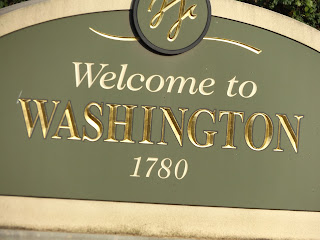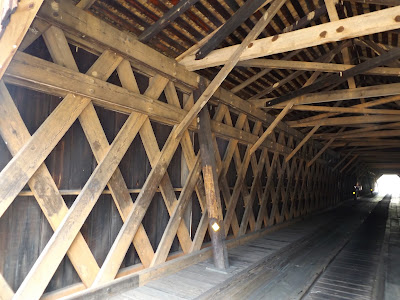July 31, 2015
Moving northward, we are again in Georgia and seeing a whale of a lot of rural countryside - lovely, rolling forested hills and open green grassy pasture land - all at a relatively higher elevation than we’ve been at, somewhere in the 500 to 800 foot range. Granted, it is very different than our mile-high status at home, but it gives a person a bit more variety.
There is also some slight change as far as nighttime cooling-off temperatures, too: we are now getting down into the mid-70s for lows - not optimum but a relief nevertheless.
This section of the Peach state is in the Piedmont, that vast area between the Appalachians to the northwest and the “fall line” where the land drops off to the seacoast plain.
The Georgia bight . . .
I had never heard of a bight, therefore was unaware that Georgia had one, but now I have and now I know. The Georgia bight is that place along the Atlantic seaboard where the coast turns inward in a long sloping westward direction. In learning about the Georgia bight, I was informed that being on the seashore of Georgia puts a person longitudinally straight south of Cleveland, Ohio. No, I didn’t believe it either, had to check on the map for verification.
Colonial times, Eagle Tavern . . .
Georgia is proud of its status as one of the 13 original American colonies; in my continuing ignorance, I never gave much thought to its history as it relates to American indpendence from Britain.
Roaming around in the Franklin & Wilkes counties region as we have been quickly set me straight on that. We were barely out of the RV park (a nice family-run woodsy place, as it turns out) before I called a halt to our forward progress. First stop was a welcome center manned by a most congenial and helpful fellow.
I asked about the hours during which a person could see the historic Eagle Tavern across the road, at which our self-proclaimed guide, Alex, offered to open it up for our personal tour. What an amazing place - constructed in 1801 or possibly before, the inn was enlarged over the years. Because of those additions, the original four-room (two up, two down) structure was somewhat protected from the elements. When the later portions were removed, it was possible to restore the striking building to its original beauty.
 |
| The Eagle Tavern before restoration; it would require some vision to see the potential. |
 |
| The Eagle Tavern with the additions removed and the original structure restored. |
 |
| The Eagle Tavern as we saw it. |
 |
| For a price, travelers would be afforded a shared space on an upstairs bed. |
 | |
| Part of the 19th century Eagle Tavern ledger was found in this trunk. |
Washington, Wilkes, weightlifters. . .
Once again taking a look for ancestors, we headed for the library in Washington, county seat of Wilkes, where our Echols, Owen and Vance ancestors spent time not too long after the American Revolution.
We knew that our Patrick Vance fought during that war for independence and was in the Battle of Kettle Creek, but our knowledge went little further than that. He was married to Sarah Harrington and was the parent of our Lydia Vance who wed Major Ezra Madison Owen.
Although 18th century records from the Georgia wilderness are scanty and/or destroyed, we managed to find a few tidbits about the family, more about the Echols branch, some of whom remained here when ours moved on (why is it that my family lines are always the ones who keep moving?).
One side of Washington's quaint downtown burned in the late 1800s, there remain around the courthouse center a number of buildings from earlier - one even dated 1815!
As I was preparing to do a few photographs, we noticed crowds beginning to gather, and it seemed fairly obvious that they were not there on my behalf. Of all the crazy things we've happened into, this had to be the most unusual: a "Lift-a-thon" was about to take place. Curiosity piqued, we must remain to witness the event.
Evidently, the high school football team gathers annually downtown to do some sort of weight-lifting event in an attempt to better any previous feats accomplished in the gym, and townsfolk gather to cheer them on. Although I think there was some system in place, it gave the impression of semi-organized chaos. Not sure, but it's possible that my mentally straining along with them helped a bit.
Finishing our short library perusal allowed us just enough time to have a tour of the Callaway Plantation. The big house, a Greek Revival mansion, was interesting; however, I was more intrigued by Aristides Callaway's earlier abodes.
Two older structures on the property were contemporary with my ancestors in that place, thus giving us a look at what surely their homes would have been like. The log cabin was built about 1785 and the gray house circa 1790.
Franklin County, library, Mexican food . . .
A wander around Carnesville, the Franklin County seat, had us wondering why we couldn't find a library, typically easy to locate in small towns. Turns out they don't even have one, which left us flabbergasted, even more so to learn the entire county has only one library, and it is not much to speak of. The librarian there was anxious to assist us and very helpful, as much as one could be when the local history section consists of no more than a half-dozen tomes.
Lunch time found us just about as bereft of eating establishments as libraries. Chris finally convinced me that we should try Georgia Mexican food, that genre being the only restaurant in sight. Nice place, great service, excellent prices, tasty salsa, but oh that chile relleno! What I have always thought was a standard entree turned out to be something else entirely.
I shall try to describe it: begin with a glop of some gruel-like substance, possibly some ground meat in a thick sauce of unknown origin, place a very small bit of a mild green chile over it and top with melted cheese and there you have it. I knew better; will we never learn?
Watson Mill Bridge . . .
This country is criss-crossed by a multitude of two-lane winding roads that wander up and down and around until I have no idea where I am nor in which direction I am traveling. On one such back road traverse, we made a stop to see the Watson Mill Bridge.
It seems the Watson Mill, once a fixture on the South Fork River, is no more; however, the covered bridge there is said to be the longest such span in Georgia at 229 feet. An 1885 one-laner, it is interestingly constructed - supported by a town lattice truss system held together by wooden pins, so states the accompanying brochure.
The place is a state park; a number of people were cooling off in the shallow water, which would be considered tepid except in comparison to the air temperature. Being of a perverse nature, we opted for a two-and-a-half mile hike through the woods.
This forest offers a shady canopy but is of an entirely different nature than the sub-tropical jungle-like places we were in down Florida way. The respite from sunshine did not seem to moderate the termperatures at all, but we quite enjoyed our walk, nevertheless.
It doesn't take much exertion, usually none at all, to break out in the sweaty shiny Southern skin sheen, and this was no exception.

















3 comments:
HISTORY..I LOVE IT!
Yup, it's our thing, Bobbi; I'm glad you and I share that interest.
Post a Comment